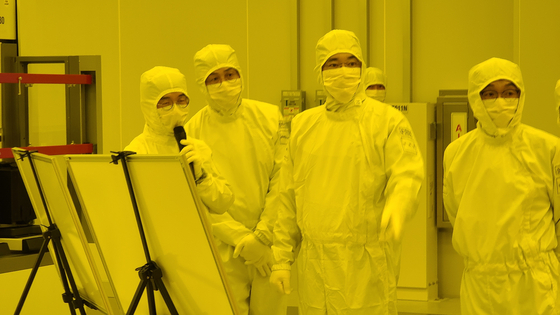
Vice Chairman Lee Jae-yong visited the Pyeongtaek semiconductor business site in January. Photo Samsung Electronics
Among the top 10 domestic groups last year, which was hit by a new coronavirus infection (Corona 19), operating profit increased was limited to the semiconductor, chemical, and securities industries. The remaining five locations, including automobiles, steel, shipbuilding, and oil refineries, were unable to escape the aftermath of Corona 19 as operating profits shrank. Accordingly, it is analyzed that the performance of small and medium-sized enterprises, such as the partners of large corporations, has also been sluggish, and the polarization between large and small and medium-sized companies has intensified due to Corona 19.
Performance analysis of representative affiliates of the top 10 groups last year
On the 21st, the JoongAng Ilbo analyzed last year’s performance on 10 representative subsidiaries (based on market capitalization) of the top 10 groups. Appeared to increase. By industry, there are 2 semiconductors, 2 chemicals and 1 securities. However, the operating profits of Hyundai Motor Company, Korea Shipbuilding & Marine Engineering, POSCO, Lotte Chemical, and GS Caltex were estimated to have decreased. Professor Lee Byung-tae of KAIST’s Graduate School of Techno Management said, “The impact of the performance of each industry due to the external variable called Corona 19 was clearly revealed.” “He said.
Semiconductor, battery, solar power performance
The industry that performed the best in the spread of Corona 19 was semiconductor. This is due to the increase in demand due to the expansion of non-face-to-face cultures such as working from home, classes, and online shopping, and the expansion of data servers and centers to support them. Samsung Electronics’ operating profit last year was 35.993 trillion won, an increase of 29.6% from the previous year. SK Hynix also recorded an operating profit of 5,126 trillion won, an 84% increase from the previous year.
Chemical companies took advantage of reflective profits as raw material prices such as low oil prices fell due to Corona 19. Last year, LG Chem’s sales (30 trillion 57.4 billion won) increased slightly (9.9%) from 2019, but its operating profit (2.353.1 billion won) increased 185.1%. Hanwha Solutions’ sales (9,195 billion won) decreased by 2.8%, but its operating profit (594.2 billion won) increased 29.4%. In addition, LG Chem’s electric vehicle battery and Hanwha Solutions’ solar power led the analysis. On the other hand, Lotte Chemical’s operating profit (353.3 billion won) fell sharply (-68.1%). Last year, the fire at the Daesan plant in Chungnam was affected by the downtime and restoration costs.

Only half of the core affiliates of the top 10 groups laughed. Graphic = Kim Eun-kyo [email protected]
The analysis that the impact of Corona 19 is also the 36.8% increase in the operating profit of NH Investment & Securities, a subsidiary of the National Agricultural Cooperative Federation, of 787.3 billion won. It is said to have benefited from the flow of current funds to the stock market with interest rates falling to record lows. In 2019, the ratio of the total operating profits of 20 securities companies including NH Investment & Securities to the operating profits of the four major banks (Kookmin, Shinhan, Hana, and Woori) was about 100 to 52.4. But last year, this number was 100 to 71.8. This is the result of the inflow of money to the securities companies, and thus the operating profits of the securities companies increased.
Car, steel, shipbuilding, and oil refineries are sluggish
However, due to Corona 19, operating profits in industries such as automobiles, steel, shipbuilding, and oil refineries declined. Hyundai Motor’s operating profit (2,781.3 billion won) decreased (-22.9%) compared to a year ago, but this is the result of stopping the decline in annual earnings due to the large number of vehicles sold in the domestic market in the fourth quarter of last year. POSCO’s operating profit (2.403 trillion won) also decreased (-37.9%), and Korea Offshore & Shipbuilding also recorded an operating profit of 74.4 billion won (-74.4%) compared to 2019. In addition, GS Caltex’s operating profit decreased (-54.7%) due to a decrease in demand.
In particular, in industries such as steel, shipbuilding and oil refining, it is analyzed that small and medium-sized business partners could have suffered sluggishness as sales decreased even for large companies. Professor Seong Tae-yoon of the Yonsei University Department of Economics said, “The back effect that leads to profits from small and medium-sized business partners is much greater in the automobile, steel, and shipbuilding industries than in the semiconductor industry.”

The Hyundai Motor Research Institute in Hwaseong, Gyeonggi-do visited by Prime Minister Jeong Sye-gyun on the 18th. yunhap news
Concerns about widening the gap between large and small companies
In fact, according to a recent announcement by the Small and Medium Business Administration, 53.9% of the SMEs surveyed answered that “the sales in 2020 were less than the previous year.” Large corporations such as Hyundai Motor can make future investments such as taking over robotics companies even when operating profit declines, but SMEs are worried that the gap may widen after the overcoming of Corona 19 because SMEs have no room. Accordingly, the SMEs are urging SMEs to extend their loan maturity and postpone interest repayment.
“The reality is that about 80% of sales in the SME manufacturing industry depend on large corporations,” said Chu Moon-gap, head of the Economic Policy Division of the Mid-sized Enterprises. Some argue that measures that can lead to the growth of the energy industry are needed to lead to SMEs.” “The growth of large companies such as Hanwha Solutions is difficult to lead to SMEs because a large portion of the materials for solar components are made in China. It is necessary to make efforts to localize new and renewable energy power generation materials by supporting a large portion of the New Deal budget to SMEs.”
Reporter Sunwook Choi [email protected]
